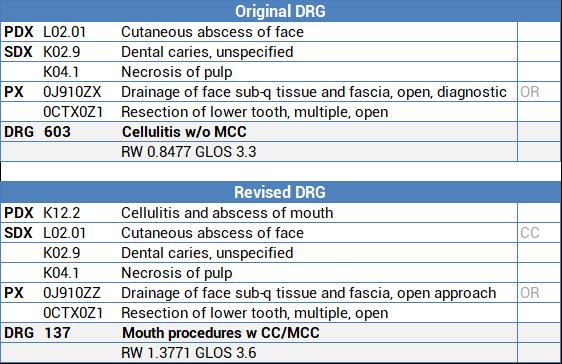Provident has been engaged in ongoing DRG audits since ICD-10 was implemented in October 2015. We have identified potential DRG audit target areas related to our audit work, changes to the ICD-10 codeset, and Coding Clinic updates. We will be posting cases regularly in our newsletter. Please see this edition’s case study below:
Case Summary
The patient is a 36-year-old who presented to the hospital complaining of left-sided facial pain and swelling due to submental abscess. CT imaging revealed a fluid collection in the left submandibular space associated with necrotic tooth #17. It was also noted that tooth #19 had periapical radiolucencies indicating a periapical abscess. Oral and maxillofacial surgery (OMFS) was consulted to evaluate and treat the patient. The patient was admitted to the OMFS service and placed on IV antibiotics. The patient was taken to the OR and tolerated the procedure well and there were no complications.
CT NECK SOFT TISSUE WITH CONTRAST
IMPRESSION:
1. Moderate-sized abscess is noted in the left side of the floor of mouth. The cavity shows fluid along with air pockets. The abscess cavity is seen tracking superiorly to as the left side of the body of mandible.
POSTOPERATIVE DIAGNOSES:
1. Grossly carious teeth #17 and 19.
2. Left submandibular space abscess.
PROCEDURES:
1. Surgical extraction of teeth #17 and #19.
2. Incision and drainage of left submandibular space abscess.
OPERATIVE REPORT (excerpt):
A 15 blade was used to make an incision through skin and subcutaneous tissue, approximately 2 fingerbreadths before the inferior border of the mandible on the left side at the crest of the loculation about 1.5 cm in length. Blunt dissection was then carried through the platysma and the superficial layer of the deep cervical fascia up to the inferior border of the mandible into the pocket of the loculation. Dissection was carried out along the medial aspect of the mandible and the inferior border easily into the preexisting pocket from the swelling. Purulence was expressed from the area. Attention was then turned intraorally where a 15 blade was used to make sulcular incision from tooth #17 through #19. Envelope flap was elevated to the buccal and lingual aspects of the teeth. Dental elevators and forceps were used to extract teeth #17 and #19. Thorough curettage of the region was done with normal saline and then through the extraoral incision site was used to irrigate copiously with through and through communication from the extraoral incision to the intraoral extraction sites.
DRG Options

Audit Considerations & Strategies
- The principal diagnosis assigned by the coder was L02.01 (Cutaneous abscess of face) for the submental abscess
- However, since the patient was also found to have a submandibular space abscess, we recommend adding K12.2 (Cellulitis and abscess of mouth) and assigning as the principal diagnosis since it was the indication for surgery
- The coder assigned 0J910ZX (Drainage of face subcutaneous tissue and fascia, percutaneous approach, diagnostic)
- However, since the incision and drainage was therapeutic, we recommend assigning 0J910ZZ (Drainage of face, subcutaneous tissue and fascia, open approach, no qualifier (therapeutic)
- Revising the principal diagnosis and procedure shifts the DRG from 603 (Cellulitis without MCC) to 137 (Mouth procedures with CC/MCC)
- If there is a therapeutic component to the procedure, only the qualifier “Z” is used, rather than the qualifier “X.” The qualifier “X” is exclusively used for diagnostic procedures only.
- If there are two separate procedures, one diagnostic and the other therapeutic, then both procedures are code separately.
- For example, a diagnostic drainage procedure that uses a different approach or samples a different site from the therapeutic drainage procedure requires two separate codes to capture both the diagnostic procedure (biopsy) and the therapeutic procedure
- In this case, the incision and drainage was performed to surgically treat the submandibular abscess, and therefore the qualifier (Z) No Qualifier should be assigned rather than (X) Diagnostic
- Always ensure the most appropriate qualifier (i.e. (X) Diagnostic or (Z) No Qualifier) is assigned when reviewing surgical cases since the (Z) qualifier will often shift the Medical DRG to a surgical DRG
Reference
- Incision and Drainage of Submandibular Space, Coding Clinic – 3rd Quarter 2018: Page 16
- Therapeutic and Diagnostic Paracentesis, Coding Clinic – 3rd Quarter 2017: Page 12
